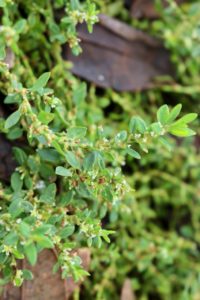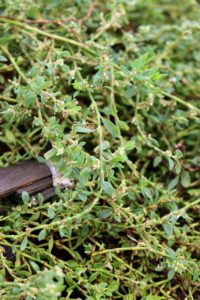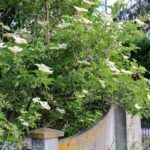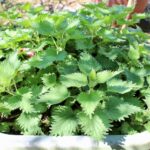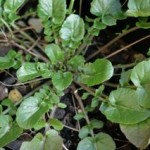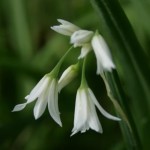In downtown Tauranga between the carpark and main street I saw this spreading plant known as small-leaved wireweed Polygonum arenastrum. Tourists were taking photos of art items and I was taking photos of weeds! I marvelled at how it was nicely covering quite a patch, quietly and invisibly doing it’s healing work to cover the earth, although in this case asphalt. How long would it be before everything was covered again in plants, if we suddenly weren’t there? Surprisingly fast if you’ve seen the vacant lots in Christchurch that have been colonised by ‘weeds’ since the earthquake.
Wireweed is in the Polygonaceae or dock family including Buckwheat Fagopyrum esculentrum, Sheep’s sorrel Rumex acetosella, and others. It has wiry, trailing stems with swollen joints where new leaves form. The Greek word Polygonaceae means ‘many knees’ in reference to these joints. The tough stems come from a tap root, that is hard to get out and can sprawl out over a metre.
Two to five tiny white or pink flowers form between the leaf and the stem.
Seeds or rather a three-angled nut follow, that are triangular, brown and hard to see because they are hidden by dead flowers.
The wireweed that I ate all spring and summer is Polygonum aviculare. It has bigger leaves than arenastrum mentioned above. It grew as an opportunist in my vegetable patch and I picked the tips of the stems, which were the most tender to add to my smoothies. I could also have added it to salads and soups. It certainly spreads out, so I had to keep it trimmed or else it would grow over the vegetables. But I could have been drying those stems I cut for later use. And I’ve since learned one can harvest the whole plant including the roots, dry it and then grind it up to make a protein rich powder to add to recipes. I’ll be trying that next season.
Wireweed is rich in carbohydrates, fats, fibre and protein. It is also loaded with minerals including calcium, phosphorus, potassium, iron, magnesium, zinc and vitamins B1 thiamine, B2 riboflavin and B3 niacin.
It has a number of medicinal uses including reducing swelling and inflammation of tissues and joints. This makes sense to me because of the thickened nodes on the stems that resemble our joints. It removes mucous from respiratory passages, stops bleeding and can destroy
parasites.
Wireweed can be taken as a tea from fresh stems, or all winter from the
dried material. My source of information said it could be taken by pregnant women to ensure the baby’s health and for preventing premature births.
I had not eaten this plant before this spring/summer season and know how nourishing it is for us. This is another example of a plant we normally toss aside actually being beneficial for us and for the earth it is trying to cover, keep moist and build fertility.
References: Blair, K., 2014, The Wild Wisdom of Weeds: 13 essential plants for Human survival.
Popay,I., Champion,P., James., 2010, Common Weeds of New Zealand: third edition.

